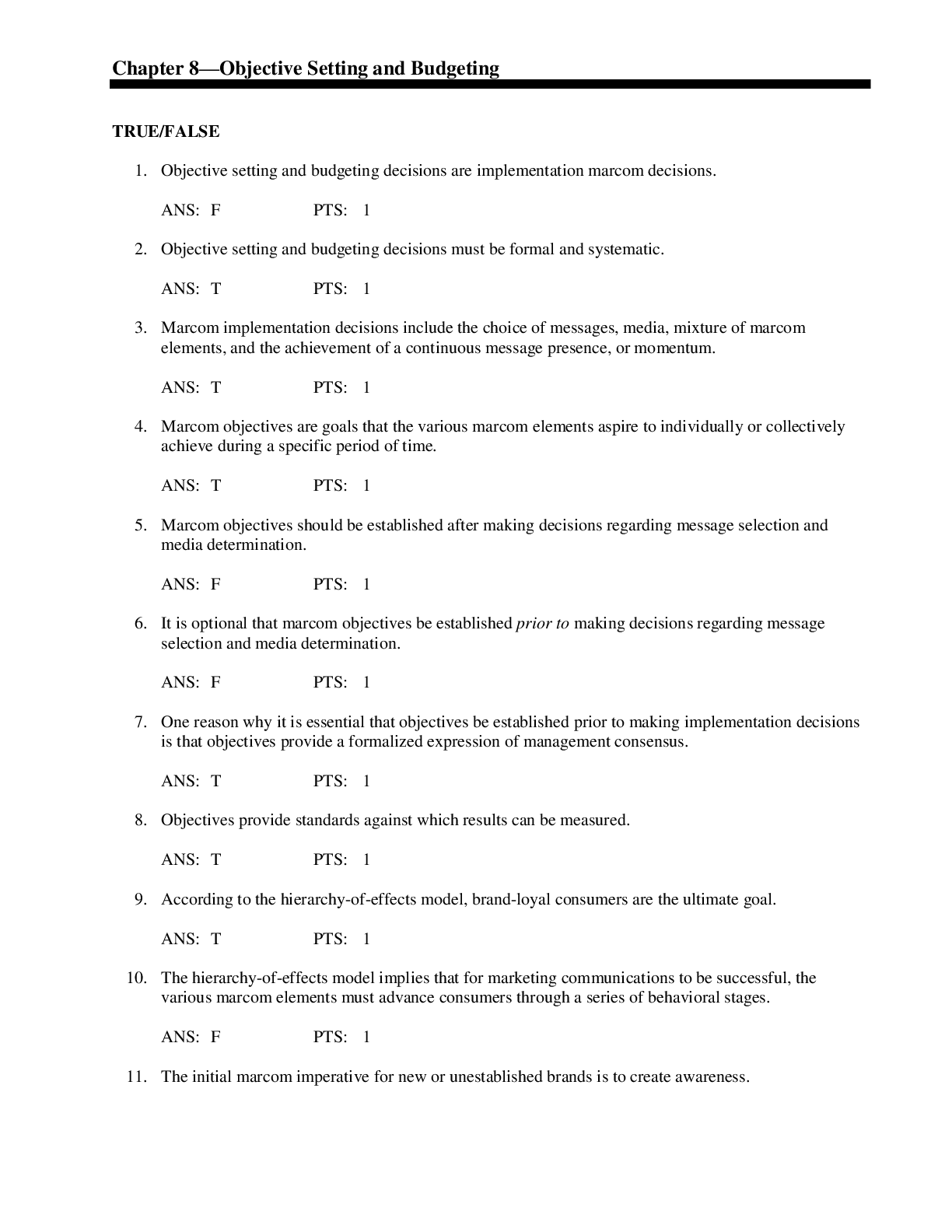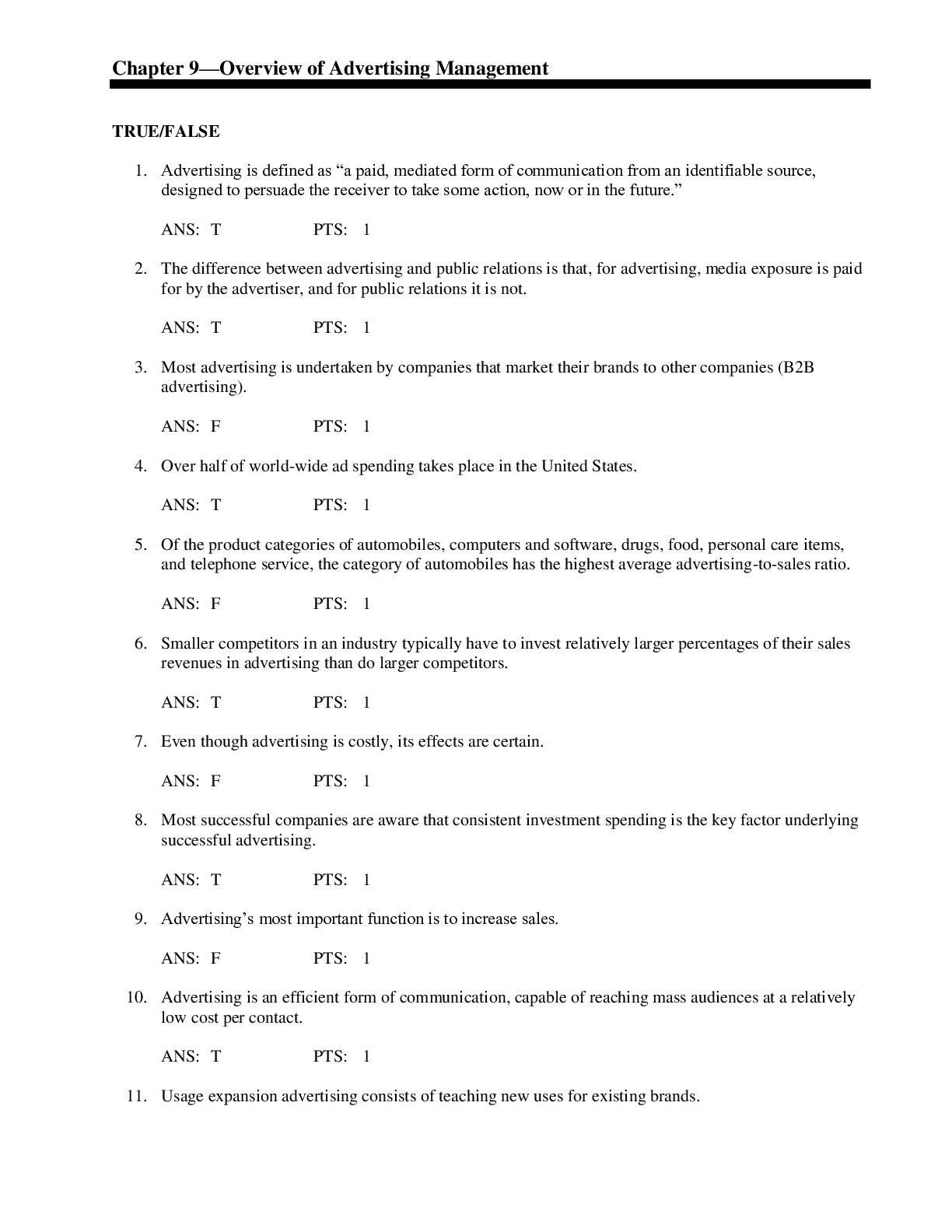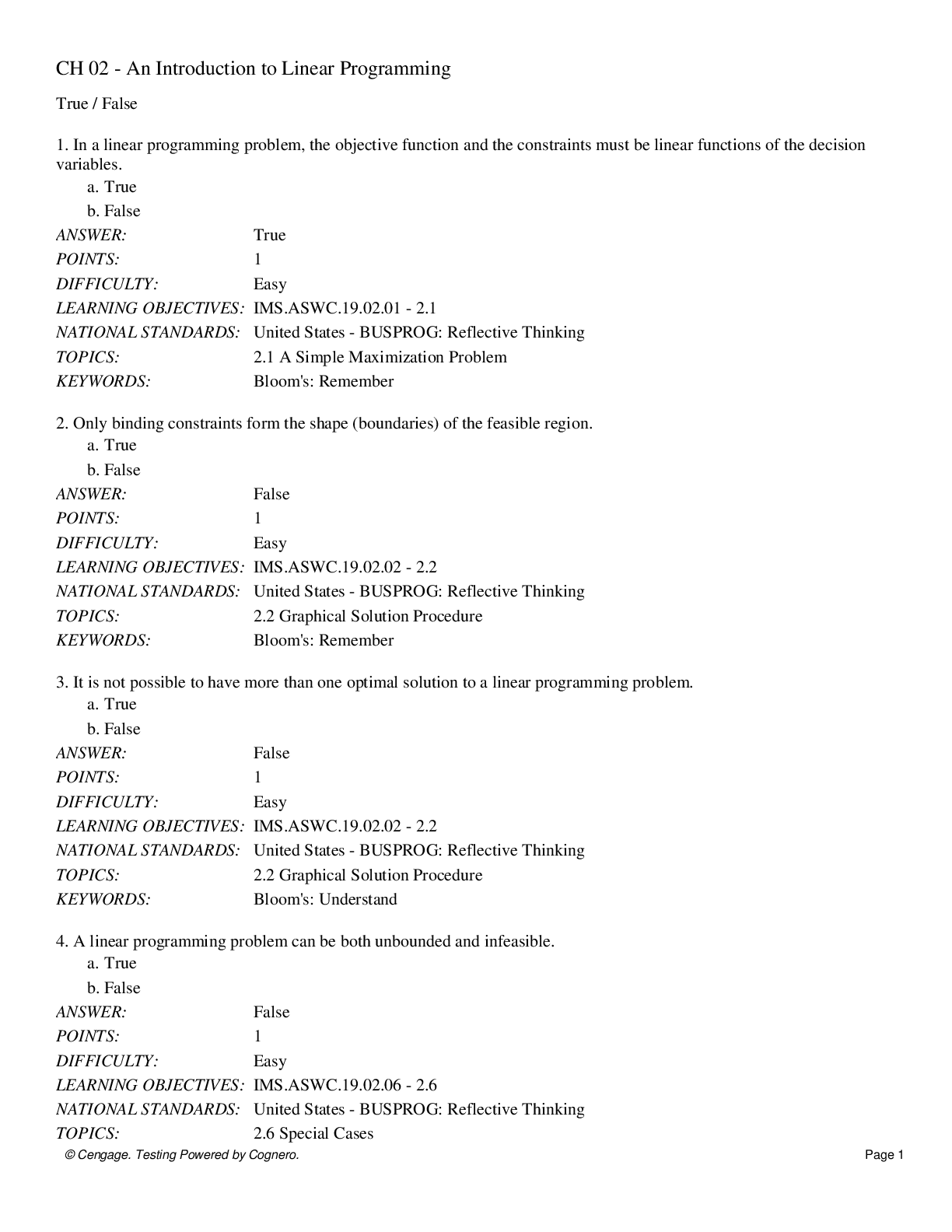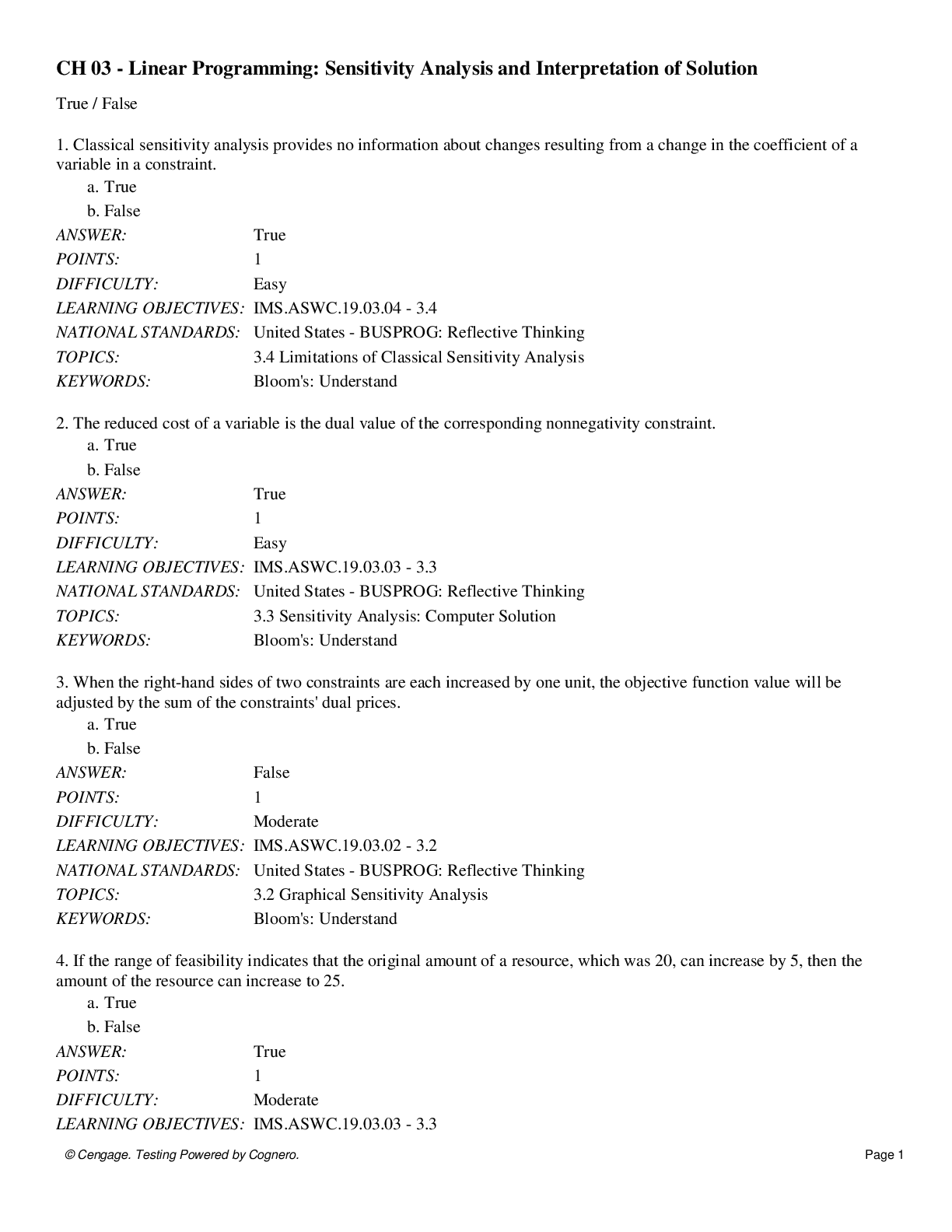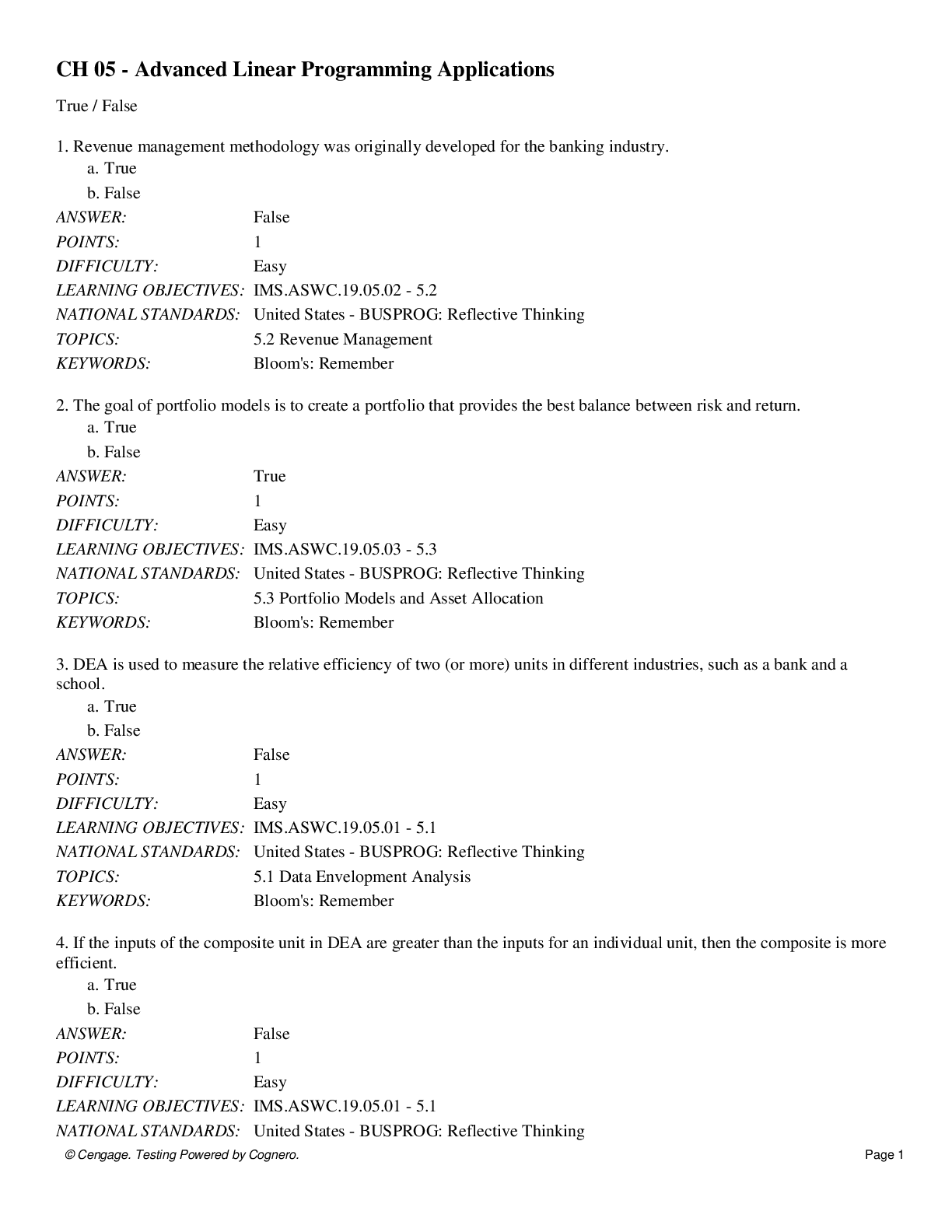*NURSING > QUESTIONS & ANSWERS > Medical Surgical Nursing, Care of Clients with HIV Disease and Other Immune Deficiencies, Correctly (All)
Medical Surgical Nursing, Care of Clients with HIV Disease and Other Immune Deficiencies, Correctly Answered Questions, All Correct Test bank Questions and Answers with Explanations (latest Update), 100% Correct, Download to Score A
Document Content and Description Below
Chapter 67: Care of Patients with Diabetes Mellitus Test Bank MULTIPLE CHOICE 1. In preparing a staff in-service presentation about diabetes mellitus, the nurse includes which information? a. Dia... betes increases the risk for development of epilepsy. b. The cure for diabetes is the administration of insulin. c. Diabetes increases the risk for development of cardiovascular disease. d. Carbohydrate metabolism is altered in diabetes, but protein metabolism is normal. ANS: C Diabetes mellitus is a major risk factor for morbidity and mortality caused by coronary artery disease, cerebrovascular disease, and peripheral vascular disease. Insulin is a lifelong treatment for some diabetic clients. Because insulin regulates the metabolism of carbohydrates, fats, and protein, abnormalities in insulin production or use alter their metabolism. DIF: Cognitive Level: Knowledge/Remembering REF: p. 1411 TOP: Client Needs Category: Physiological Integrity (Physiological Adaptation—Pathophysiology) MSC: Integrated Process: Nursing Process (Assessment) 2. A client with diabetes asks the nurse why it is necessary to maintain blood glucose levels no lower than about 60 mg/dL. Which is the nurse’s best response? a. “Glucose is the only fuel used by the body to produce the energy that it needs.” b. “Your brain needs a constant supply of glucose because it cannot store it.” c. “Without a minimum level of glucose, your body does not make red blood cells.” d. “Glucose in the blood prevents the formation of lactic acid and prevents acidosis.” ANS: B Because the brain cannot synthesize or store significant amounts of glucose, a continuous supply from the body’s circulation is needed to meet the fuel demands of the central nervous system. The other statements are not accurate. DIF: Cognitive Level: Comprehension/Understanding REF: p. 1411 TOP: Client Needs Category: Physiological Integrity (Physiological Adaptation—Pathophysiology) MSC: Integrated Process: Teaching/Learning 3. The nurse is monitoring a client with hypoglycemia. Glucagon provides which function? a. It enhances the activity of insulin, restoring blood glucose levels to normal more quickly after a high-calorie meal. b. It is a storage form of glucose and can be broken down for energy when blood glucose levels are low. c. It converts excess glucose into glycogen, lowering blood glucose levels in times of excess. d. It prevents hypoglycemia by promoting release of glucose from liver storage sites. ANS: D Glycogen is a counterregulatory hormone secreted by the alpha cells of the pancreas when blood glucose levels are low. The actions of glycogen that raise blood glucose levels include stimulating the liver to break down glycogen (glycogenolysis) and forming new glucose from protein breakdown (gluconeogenesis). The other statements are not accurate descriptions of the actions of glucagon. DIF: Cognitive Level: Knowledge/Remembering REF: p. 1412 TOP: Client Needs Category: Physiological Integrity (Physiological Adaptation—Pathophysiology) MSC: Integrated Process: Nursing Process (Analysis) 4. A client with untreated diabetes mellitus has polyuria, is lethargic, and has a blood glucose of 560 mg/dL. The nurse correlates the polyuria with which finding? a. Serum sodium, 163 mEq/L b. Serum creatinine, 1.6 mg/dL c. Presence of urine ketone bodies d. Serum osmolarity, 375 mOsm/kg ANS: D Hyperglycemia causes hyperosmolarity of extracellular fluid. This leads to polyuria from an osmotic diuresis. The client’s serum osmolarity is high. The client’s sodium would be expected to be high owing to dehydration. Urine ketone bodies and serum creatinine are not related to the polyuria. DIF: Cognitive Level: Application/Applying or higher REF: N/A TOP: Client Needs Category: Physiological Integrity (Physiological Adaptation—Pathophysiology) MSC: Integrated Process: Nursing Process (Analysis) 5. A client with diabetes has a serum creatinine of 1.9 mg/dL. The nurse correlates which urinalysis finding with this client? a. Ketone bodies in the urine during acidosis b. Glucose in the urine during hyperglycemia c. Protein in the urine during a random urinalysis d. White blood cells in the urine during a random urinalysis ANS: C Urine should not contain protein. The presence of proteinuria in a diabetic client marks the beginning of kidney problems known as diabetic nephropathy, which progresses eventually to end-stage kidney disease. Decline in kidney function is assessed with serum creatinine. This client’s creatinine level is high. The other findings would not be correlated with declining kidney function. DIF: Cognitive Level: Application/Applying or higher REF: N/A TOP: Client Needs Category: Physiological Integrity (Reduction of Risk Potential—Laboratory Values) MSC: Integrated Process: Nursing Process (Assessment) 6. A young adult client newly diagnosed with type 1 diabetes mellitus has been taught about selfcare. Which statement by the client indicates a good understanding of needed eye examinations? a. “At my age, I should continue seeing the ophthalmologist as I usually do.” b. “I will see the eye doctor whenever I have a vision problem and yearly after age 40.” c. “My vision will change quickly now. I should see the ophthalmologist twice a year.” d. “Diabetes can cause blindness, so I should see the ophthalmologist yearly.” ANS: D Diabetic retinopathy is a leading cause of blindness in North America. All clients with diabetes, regardless of age, should be examined by an ophthalmologist (rather than an optometrist or optician) at diagnosis and at least yearly thereafter. DIF: Cognitive Level: Application/Applying or higher REF: N/A TOP: Client Needs Category: Health Promotion and Maintenance (Self-Care) MSC: Integrated Process: Teaching/Learning 7. During assessment of a client with a 15-year history of diabetes, the nurse notes that the client has decreased tactile sensation in both feet. Which action does the nurse take first? a. Document the finding in the client’s chart. b. Test sensory perception in the client’s hands. c. Examine the client’s feet for signs of injury. d. Notify the health care provider. ANS: C Diabetic neuropathy is common when the disease is of long duration. The client is at great risk for injury in any area with decreased sensation because he or she is less able to feel injurious events. Feet are common locations for neuropathy and injury, so the nurse should inspect them for any signs of injury. After assessing, the nurse should document findings in the client’s chart. Testing sensory perception in the hands may or may not be needed. The health care provider can be notified after assessment and documentation have been completed. DIF: Cognitive Level: Application/Applying or higher REF: N/A TOP: Client Needs Category: Physiological Integrity (Reduction of Risk Potential—Potential for Complications from Surgical Procedures and Health Alterations) MSC: Integrated Process: Nursing Process (Analysis) 8. A client’s father has type 1 diabetes mellitus. The client asks if she is in danger of developing the disease as well. Which is the nurse’s best response? a. “Your risk of diabetes is higher than that of the general population, but it may not occur.” b. “No genetic risk is associated with the development of type 1 diabetes.” c. “The risk for becoming diabetic is 50% because of how it is inherited.” d. “Female children do not inherit diabetes, but male children will.” ANS: A Risk for type 1 diabetes is determined by inheritance of genes coding for HLA-DR and HLADQ tissue types. Clients who have one parent with type 1 diabetes are at increased risk for its development. Diabetes (type 1) seems to require interaction between inherited risk and environmental factors, so not everyone with these genes develops diabetes. The other statements are not accurate. DIF: Cognitive Level: Comprehension/Understanding REF: p. 1416 TOP: Client Needs Category: Physiological Integrity (Physiological Adaptation—Pathophysiology) MSC: Integrated Process: Teaching/Learning 9. A client has newly diagnosed diabetes. To delay the onset of microvascular and macrovascular complications in this client, the nurse [Show More]
Last updated: 1 year ago
Preview 1 out of 22 pages
Instant download

Buy this document to get the full access instantly
Instant Download Access after purchase
Add to cartInstant download
Reviews( 0 )
Document information
Connected school, study & course
About the document
Uploaded On
Dec 19, 2021
Number of pages
22
Written in
Additional information
This document has been written for:
Uploaded
Dec 19, 2021
Downloads
0
Views
82

.png)
.png)
.png)
.png)
.png)
.png)
.png)
.png)
.png)
.png)
.png)





